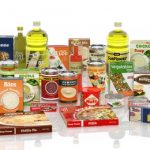
Food labelling and how that food is packaged are one of the most important aspects of law when offering products for sale and for consumption. It applies to small-scale caterers as well as those selling packaged products from a factory. Any food offered must obey Article 16 of The General Food Law Regulation (EC) 178/2002. This law clearly states that any foods presented for sale within a premises should not mislead consumers, and neither should the labelling, advertising and presentation of that food.
The UK Government web-site gives a full and explicit explanation of the labelling requirements.
How Should The Information be Presented
There is a certain amount of basic information required on the label and a list of all the ingredients. When we sell any food or beverage the label must obey the following:-
- Clear and easy to read
- Easy to understand
- Visible
- Not misleading
- Permanent and not temporary or too easily removed.
- Provide warnings where required
Labelling should clearly stipulate the product for sale which is known as the ‘legal definition’, as well as address any allergen information contained within the food on the packaging.
What Must be Shown On A Food Label
The following mandatory information must be shown on the front of a packaged food:-
- The legal name of the food or products
- A ‘best before’ or ‘use by’ date. Instructions must be provided on how to find it if it is not immediately visible.
- All warnings
- Amounts and quantity information of certain ingredients
- Net quantity
- Instructions for use (if needed)
- Indication of minimum durability (‘Use by’ or ‘best before’ dates)
- Storage conditions and/or conditions of use
Other information which must be shown can be shown on the front, side or back of the packaging.
- A list of all ingredients even if there are more than two.
- The name and address of the manufacturer, packer or seller.
- The lot number or use-by-date if required.
- Any special or specific storage conditions which keeps the food in good quality.
- Instructions on how to use the food such as preparation, cooking etc.
- Place of origin or provenance (if implied)
- Food allergens (14 in total plus their derivatives)
- Nutrition information
- Alcohol strength (for beverages with more than 1.2% alcohol).
Mandatory Information
The name of the food
It is illegal for any food to have a false or misleading name of description.
In the naming lexicon there are three types.
- Legal name
- Customary name
- Descriptive name
2. The Ingredients List
- The list of ingredients on a food label must actually have a heading that includes the word ‘ingredients’.
- The ingredients are generally listed in descending order of weight when the product was prepared.
Quantity Information & Amounts
The net quantity is always stated on the label and is quoted in grams, kilograms, millilitres or litres. It is the weight or volume of the product without any packaging.
The net quantity is always stated for packaged foods over 5g or 5ml and for packaged herbs and spices. It must be clear about how many items are available in a package and the quantity information must be very clearly expressed. It is always provided in metric units (kilos and grams or litres, centilitres and millilitres).
In retailing, it is quite common to see a bar code but this is not required by law.
Quantitative Ingredient Declaration (QUID) In Food Labelling
The QUID is when ingredients are emphasised on the label to categorise the food, the quantities of these ingredients should be shown to make sure that consumers are not misled.
It should be used where:
• the ingredient is in the name of the food or is usually associated with that name
• the ingredient is emphasised on the labelling in words, pictures or graphics
• the ingredient is essential to characterise a food and to distinguish it from another product that it could be confused with.
The minimum percentage of the ingredient in the food must be given either next to the name of the food or in the ingredients list.
Presenting Information – A Minimum Font Size
One of the major consumer complaints about food labelling is the small size of print on labels. There is a minimum font size which is set for all mandatory information on most food labels. The minimum font size is:-
- 1.2mm (“-height”)
- 0.9mm largest surface less than 80cm²
Instructions For Use
Manufacturers usually have instruction for preparing a food. These might be cooking instructions, how to cook from frozen for example.
Indications For Minimum Durability
This information is about the storage and use of food which aims to help consumers to use food safely and reduce waste.
There are two main types of date marks required
1. Best before
– This date mark appears on most pre-packaged foods
– Consumers can use the food after this date but it may not be best quality
Use by
– This date mark appears on perishable foods
– Consumers risk food poisoning if they use the food after this date
The name or business name and address of the food business operator.
• The label should contain the name or business name and address of the food business operator
in the European Union.
• If a consumer is not satisfied with how a food is labelled, they should contact the food business
operator.
Country of origin or place of provenance
• Country of origin or place of provenance becomes mandatory on a label if the name implies that the food comes from or has been made in a different country to where it was produced.
There is a great example from a GCE exam which states how a salmon from one country and produced in another would be labelled:
Salmon smoked in Ireland but made from Norwegian salmon should not be described as ‘Irish smoked salmon’ but as ‘Norwegian salmon smoked in Ireland,’ or ‘Imported salmon smoked in Ireland.’
If the Norwegian salmon had been labelled as ‘Irish Smoked Salmon’ in the example below this would be incorrect, because it implies that the salmon came from Ireland when it is in fact Norwegian.
From 1st April 2015 country of origin labelling will be mandatory for fresh, chilled and frozen meat from pig sheep, goat and poultry.
Food allergens To Be Listed In Food Labelling
• Food allergy, food intolerance and coeliac disease can cause some people to become ill.
• It is important that food labels help people with a food allergy, food intolerance or coeliac disease to make safe food choices.
• There are 14 food allergens (including derivatives) that by law must be emphasised in the ingredients list on the label if they are deliberately added.
Note: *Food that is labelled ‘gluten free’ contains less than 20mg/kg gluten.
Food that is labelled ‘very low gluten’ contains less than 100mg/kg gluten.
Nutrition labelling
If a nutrition or health claim is made about a food e.g. High Fibre or low in fat, nutrition information has
to be provided. Nutrition labelling will become a mandatory requirement from 13 December 2016.
• If a business is voluntarily providing a nutrition panel on their label it must comply with the requirements
of the Food Information Regulation from 13 December 2014.
• Doesn’t apply to natural mineral waters.
Salt rather than sodium content must be declared.



Leave a Reply